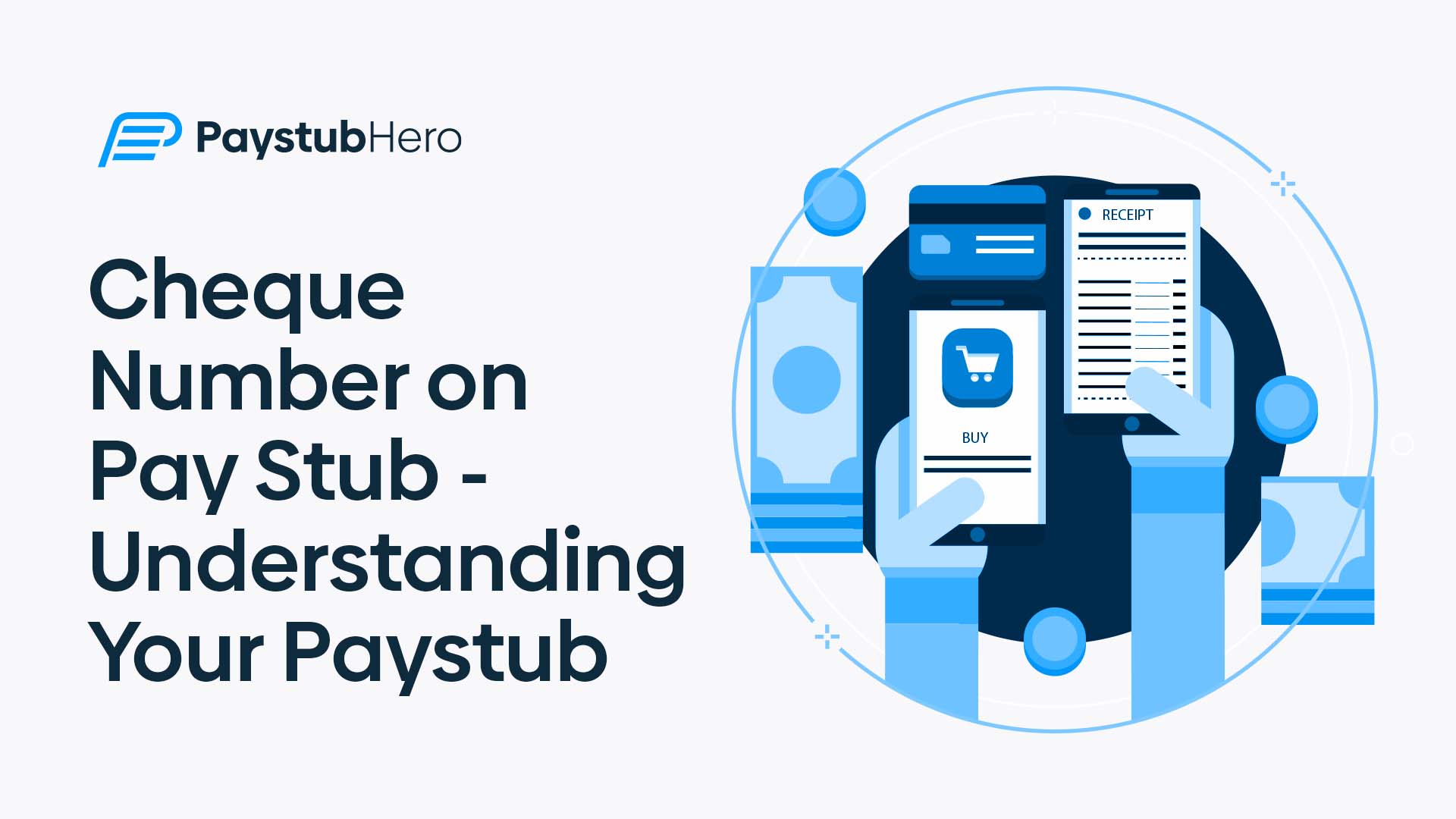Your paystub’s cheque number is just a tracking number and is a unique ID for each paycheck. Even with direct deposits, you’ll see one listed.
Here’s what it does, why it’s key, and how it fits into your paystub.
What’s the Tracking Number For?
A tracking number identifies your payment in your employer’s system. For direct deposits, it’s often labeled “Cheque No.” or “Check #,” despite no physical cheque.
It acts like a receipt, proving a specific amount was paid on a date.
What Does a Cheque Number Look Like?
It usually looks like a short string of digits. Sometimes it’s all numbers. Sometimes it’s a mix of letters and numbers.
Here are a few examples of what a cheque number might look like on your pay stub:
⦿ CHK# 002193
⦿ Cheque No: 874532
⦿ Check #: 009877
⦿ Payment Ref: DP-112233 (for direct deposits)
⦿ Pay ID: 20240503-01
Where to Find It on Your Pay Stub
Pay stubs look different depending on your employer.
But the cheque number is easy to find if you know where to look. Even with direct deposit, it’s usually labeled “Cheque No.” or “Check #.” There’s no paper cheque, just a tracking number.
Look for it in these spots:
⦿ Top-right corner of the stub
⦿ Near the payment summary section
⦿ Labeled as “Cheque No.” or “Check #” for direct deposits
⦿ Sometimes called “Payment Ref” or “Deposit ID”
Here’s a quick visual breakdown:
|
Label |
Example |
|
Cheque No. |
001582 |
|
Check # |
792113 |
|
Payment Ref |
DP-458812 |
|
Deposit ID |
EFT-20240503 |
In digital payroll like ADP or Gusto, look for it in the payment history or a corner line item.
Why the Cheque Number Matters
The cheque number plays a big role behind the scenes.
1. Payment Tracking
Every payroll run assigns a unique tracking number to your paycheck. This number ties your payment to a specific pay period and employee record.
Say you’re paid biweekly and check your January 5 deposit. Your paystub shows tracking #001107. Payroll uses it to match your hours and earnings from December 18-31. Without it, digging through records is chaos.
In PayrollOrg’s 2024 survey, 91.7% of U.S. workers use direct deposit, showing it’s the go-to method. For example, #001107 ensures your $3,200 deposit is logged correctly. It’s your key to a searchable, reliable payment history.
No mess, just clarity.
2. Proof of Payment
If your direct deposit goes missing or comes up short, payroll can track it with this number.
For instance, say tracking #000943 was set for a $2,100 deposit on April 12 but didn’t hit your account. Payroll pulls that number to check when it was sent, which account it went to, and if it cleared.
That number is your proof the payment was issued.
3. Avoids Confusion
According to MBO Partners’ 2024 survey, 65% of independent workers rely on multiple income streams for financial stability. If that’s you, keeping your pay organized is important.
Cheque numbers make it easy.
Each client or employer uses a unique number, so you can match payments to the correct pay stub. For example, say you earn $750 from Client A (cheque #567891) and $1,200 from your part-time job (cheque #993201).
Those numbers keep your records clean and avoid confusion.
Cheque Number vs. Other Numbers on a Pay Stub
It’s easy to confuse the cheque number with other numbers. Let’s break down the differences.
|
Type |
What It Does |
Example |
|
Cheque Number |
Identifies the payment (or tracking number for direct deposits) |
005729 or DP-784521 |
|
Routing Number |
Identifies the bank (for direct deposit) |
021000021 |
|
Account Number |
Identifies your specific bank account |
123456789012 |
|
Employee ID |
Identifies you in the payroll system |
EMP-00482 |
Is There a Cheque Number with Direct Deposit?
Yes, there usually is.
Even though no physical cheque is issued, a tracking number is still created. This helps you and your employer track the payment.
You might see it listed like this:
⦿ Deposit Reference: DP-784521
⦿ EFT Number: EFT-302145
So don’t ignore that number, it’s your record of payment.
What If There’s No Cheque Number?
Some employers may not display it on your pay stub, especially if they use a basic template or custom format. If you don’t see one:
➼ Check your online payroll portal – The cheque number may be shown under payment history.
➼ Ask your employer or HR – They can give you the cheque or payment reference number for any pay period.
Having that number is useful if you ever need to prove income, match deposits to stubs, or track down a payment issue.
How to Use the Cheque Number for Recordkeeping
If you’re someone who likes to stay organized, the cheque number can help.
Match It to Your Bank Deposits
When your employer issues a payment, the cheque number gets logged on your pay stub and in their records. Match it with your bank deposit to confirm the payment went through.
To understand this, here’s a sample.
If cheque #008742 shows on your stub, look for a deposit with that same number in your bank history.
Track Freelance or Contract Income
If you’re a freelancer or contractor, you might not get paid on a set schedule.
Cheque numbers help you match each pay stub to a specific job or invoice. This makes it easier to track income over time, especially during tax season.
Keep a spreadsheet or folder where you list cheque numbers, dates, amounts, and project names for quick reference.
Verify Missing Payments
If a payment doesn’t show up in your bank account, the cheque number helps payroll figure out what went wrong.
Let’s say your pay stub says cheque #001329, but there’s no matching deposit, give payroll that number. They can trace it back, see if it cleared. Or, they can confirm if it was accidentally delayed or misrouted.
Create Pay Stubs with Cheque Numbers Using Paystubhero
If you’re a freelancer, contractor, or small business owner, you might need to create your own pay stubs. Paystubhero assists you with that awesomely.
You can generate professional pay stubs with all the key details:
⦿ Gross and net pay
⦿ Taxes and deductions
⦿ Pay period dates
⦿ Cheque numbers or payment references
It’s fast, easy to use, and built for people who don’t want to deal with complex payroll software.
Whether you’re paying yourself or your team, Paystubhero gives you clean, trackable stubs every time.
FAQs
Below are some common questions about cheque numbers on paystubs.
Indirectly. It won’t appear on your W-2, but it helps keep your records clean when reporting income, especially if you're self-employed.
Not a good idea. It’s still the main ID for that payment. If anything goes wrong, it’s the number payroll will ask for.
Yes. If you get a paper check, that number in the upper-right corner is the cheque number.





